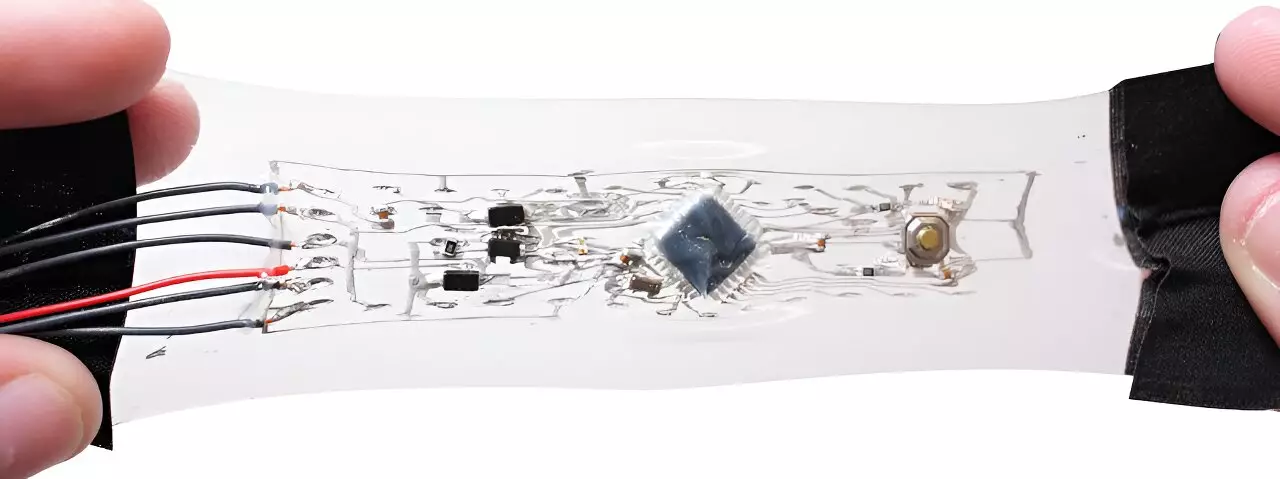In the realm of robotics and electronic devices, a burgeoning field has emerged that emphasizes flexibility and adaptability: stretchable electronics. These innovations promise to transform various sectors, from healthcare to environmental monitoring, but crafting devices that maintain functionality while allowing considerable deformation remains a significant hurdle. Researchers, notably in the ambitious lab of Prof. Rebecca Kramer-Bottiglio, are tackling these complexities head-on. Their groundbreaking advancements, as detailed in a recent publication in *Science Robotics*, focus on the development of stretchable electronics that do not compromise the essential functionalities integral to soft robots and wearable technologies.
The interplay between rigid electronic components and pliable materials is at the core of this challenge. Typically, conventional electronics featuring solid circuit boards lack the necessary flexibility to integrate seamlessly into soft robotic applications. This dissonance has led designers to position electronics externally, often diminishing the device’s overall effectiveness. It is within this context that Kramer-Bottiglio’s team has made revolutionary strides by creating stretchable Arduino prototypes that can expand significantly without losing their operational capacity.
Kramer-Bottiglio’s lab has achieved a remarkable feat: an adaptable and scalable architecture for stretchable electronics, specifically designed for integration within soft robotic platforms. Their approach successfully marries the functionalities of traditional microcontrollers with the mechanistic advantages of flexible materials. According to Stephanie Woodman, the lead author and Ph.D. candidate in the research team, they succeeded in developing a circuit capable of stretching up to four times its original length without loss of performance.
This innovation represents a significant evolution from previous prototypes, which were often singular, functionally-restricted units. The researchers’ work culminates in multilayer stretchable circuits that are not just proof of concept but can be replicated easily and consistently, opening new vistas for robotics innovation. Moreover, unlike past iterations that often required extensive knowledge in circuit design, this method simplifies the process by providing accessible, open-source resources that democratize the technology.
One striking aspect of this research is the innovative methods employed for fabrication. Starting with a gallium-based liquid metal material, the researchers developed a patently straightforward procedure for transforming this liquid into an adhesive paste that could be applied to various surfaces. By exposing it to oxygen, they facilitated the transition from a fluid state to one conducive for circuitry application. This adaptability allows the electronics to bond with both soft substrates and traditional rigid components effectively.
These fabrication processes also lend themselves to a multitude of applications. The researchers utilized laser-cut paper masks to define precise circuit patterns during the application of the metal paste, ultimately resulting in well-structured electronic components upon completing the encapsulation. Every aspect of this manufacturing process, from materials to designs, is publicly accessible, further underpinning the project’s aim toward widespread adoption.
As the technology evolves, so too does its application across various sectors. Within their experimental framework, the research teams have successfully embedded stretchable circuits into a range of soft robotic systems, demonstrating the versatility of the new electronics. One specific application involves control mechanisms for quadruped robots, where the circuitry seamlessly allows for dynamic movement while maintaining integral structural integrity.
Not limited to robotic applications, these stretchable electronics extend to wearable technology as well. The researchers highlighted their use in devices designed for aiding rehabilitation in injured limbs. One particularly challenging example involved deploying stretchable circuits around the elbow—a joint notorious for its range of motion and flexibility.
As Woodman remarked, the capacity for these circuits to stretch without interference is a significant breakthrough, suggesting that future wearable devices could be more comfortable and effective without the bulk often associated with traditional rigid electronics.
As we look ahead, the implications of these advancements in stretchable electronics are substantial. With researchers overcoming longstanding barriers between form and function, the potential applications seem limitless. Innovations in soft robotics and wearable devices stand to redefine interactions with technology, making them more intuitive, comfortable, and efficient. The combination of elasticity and reliability could lead to significant breakthroughs in healthcare, where wearable devices could provide better treatment options, or in search-and-rescue missions where resilient robots can adapt to volatile environments.
The successes demonstrated in Kramer-Bottiglio’s lab represent just the beginning of a transformative journey in the world of robotics. With exciting advancements at the intersection of functionality and design, the world may soon observe soft robots and wearable electronics deeply integrated into everyday life, shaping the future in unexpected and groundbreaking ways.

